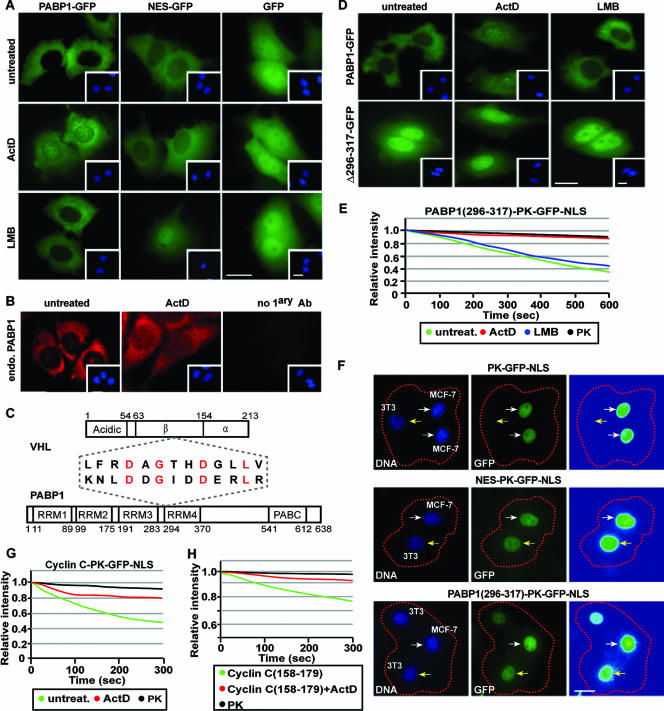FIG. 5.
VHL and PABP1 share a common transcription-dependent nuclear export motif. (A) PABP1 exports by a transcription-dependent mechanism. MCF-7 cells transiently expressing PABP1-GFP, NES-GFP, or GFP alone were either untreated or treated with 8 μM ActD or 10 μM LMB for 3 h. Insets are the corresponding Hoechst staining of the cells. Bars, 10 μm. (B) Endogenous PABP1 is also sensitive to ActD treatment. MCF-7 cells were either left untreated or were treated with 8 μM ActD. Endogenous PABP1 was detected by immunofluorescence using an anti-PABP1 antibody. Insets show nuclei stained with Hoechst stain. A primary antibody exclusion (no 1ary Ab) control is also shown. Bar, 10 μm. (C) Schematic diagram depicting a region of alignment between the nuclear export sequence of VHL and PABP1. Conserved residues are indicated in red. (D) MCF-7 cells transiently expressing PABP1(Δ296-317)-GFP or PABP1-GFP were treated as described for panel A. Insets are the corresponding Hoechst staining of the cells. Bar, 10 μm. (E) Residues 296 to 317 of PABP1 encode a transcription-dependent nuclear export sequence. Transfected MCF-7 cells were treated with 2 μM ActD or 10 μM LMB for 1 h before being submitted to cytoplasmic FLIP. The corresponding loss of nuclear fluorescence was monitored, measured, and plotted on a graph. (F) PABP1(296-317) can mediate export in a polykaryon fusion assay. MCF-7 cells (donors) were fused with NIH 3T3 cells (acceptors) using PEG, and the transfer of nuclear fluorescence from donor to acceptor cells was monitored. Donor and acceptor cells were differentiated by a cell-specific Hoechst staining pattern. White arrows indicate donor cells, and yellow arrows indicate acceptor cells. Bar, 10 μm. (G) Full-length cyclin C can export the PK-GFP-NLS reporter in a transcription-dependent manner. Cells were treated with 2 μM ActD for 1 h or untreated, and the loss of nuclear fluorescence after cytoplasmic FLIP was plotted on a graph. (H) Residues 158 to 179 of cyclin C encode a transcription-dependent nuclear export motif. The indicated constructs were transiently expressed in MCF-7 cells and treated the same as for panel G. Cells were subjected to cytoplasmic FLIP, and the corresponding kinetics for loss of nuclear fluorescence were plotted on a graph.

